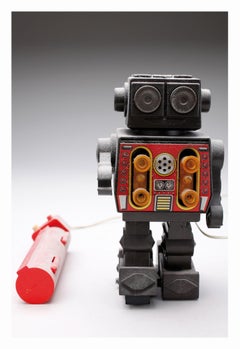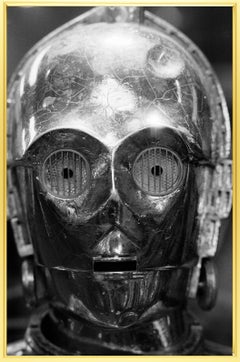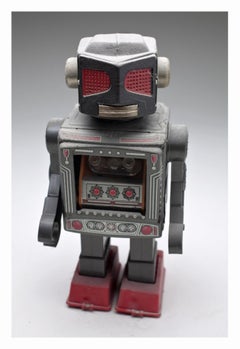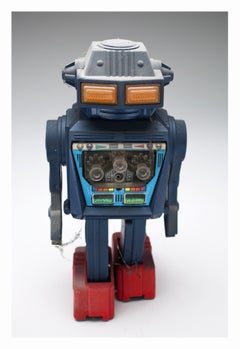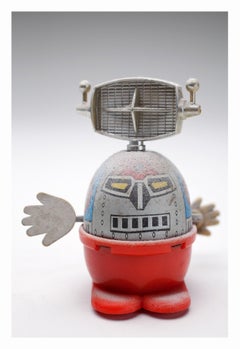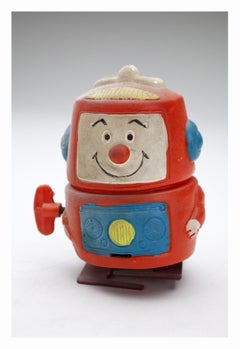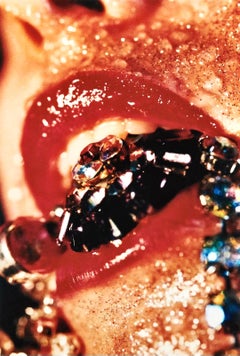Robot Figurative Photography
to
9
1
Overall Width
to
Overall Height
to
1
9
1
3
3
2
1
10
87
12,449
6,047
5,447
3,382
2,403
2,391
1,959
1,540
1,382
1,354
1,225
1,212
1,045
986
900
857
852
843
828
9
1
1
9
1
9
1
Art Subject: Robot
Untitled (from ROBOTNICS Series)
Located in Kansas City, MO
Christian Rothmann
ROBOTNICS Series
C-Print
2019
Edition S (Edition of 10)
12 x 8.3 inches (30.5 x 21 cm)
Signed, dated and numbered verso
Other Edition Sizes available:
- Edition M (Edition of 6) 35.4 x 23.6 inches (90 x 60 cm)
- Edition L (Edition of 6) 47.2 x 31.5 inches (120 x 80 cm)
- Edition XL (Edition of 3) 88.8 x 58.8 inches (225 x 150 cm)
PUR - Price Upon Request
--------------
Since 1979 Christian Rothmann had more than 40 solo and 80 group exhibitions worldwide.
Christian Rothmann had guest lectures, residencies, art fairs and biennials in Europe, Japan, USA, Australia and Korea.
Christian Rothmann (born 1954 in Kędzierzyn, Poland ) is a painter, photographer, and graphic artist.
In 1976 he first studied at the “Hochschule für Gestaltung” in Offenbach, Germany and moved to Berlin in 1977, where he graduated in 1983 at the “Hochschule der Künste”. From 1983 to 1995 he taught at the university as a lecturer and as an artist with a focus on screenprinting and American art history. To date, a versatile body of work has been created, which includes not only paintings but also long-standing photo projects, videos, and public art.
Guest lectures, teaching assignments, scholarships and exhibitions regularly lead Rothmann to travel home and abroad.
------------------------
Rothmann's Robots
These creatures date back to another era, and they connect the past and the future. They were found by Christian Rothmann, a Berlin artist, collector and traveler through time and the world: In shops in Germany and Japan, Israel and America, his keen eye picks out objects cast aside by previous generations, but which lend themselves to his own work. In a similar way, he came across a stash of historic toy robots of varied provenance collected by a Berlin gallery owner many years ago. Most of them were screwed and riveted together in the 1960s and 70s by Metal House, a Japanese company that still exists today. In systematically photographing these humanoids made of tin - and later plastic - Rothmann is paraphrasing the idea of appropriation art. Unknown names designed and made the toys, which some five decades on, Rothmann depicts and emblematizes in his extensive photo sequence.
In their photographs of Selim Varol's vast toy collection, his German colleagues Daniel and Geo Fuchs captured both the stereotypical and individual in plastic figures that imitate superheroes which were and still are generally manufactured somewhere in Asia. Christian Rothmann looks his robots deep in their artificially stylized, painted or corrugated eyes - or more aptly, their eye slits - and although each has a certain degree of individuality, the little figures remain unknown to us; they project nothing and are not alter egos. Rothmann trains his lens on their faces and expressions, and thus, his portraits are born. Up extremely close, dust, dents, and rust become visible. In other words, what we see is time-traces of time that has passed since the figures were made, or during their period in a Berlin attic, and - considering that he robots date back to Rothmann's childhood - time lived by the photographer and recipients of his pictures. But unlike dolls, these mechanical robots bear no reference to the ideal of beauty at the time of their manufacture, and their features are in no way modeled on a concrete child's face.
In this art project the robots appear as figures without a context, photographed face-on, cropped in front of a neutral background and reduced to their qualities of form. But beyond the reproduction and documentation a game with surfaces is going on; our view lingers on the outer skin of the object, or on the layer over it. The inside - which can be found beneath - is to an extent metaphysical, occurring inside the observer's mind. Only rarely is there anything to see behind the robot's helmet. When an occasional human face does peer out, it turns the figure into a robot-like protective casing for an astronaut of the future.
If we really stop and think about modern toys, let's say those produced from the mid 20th century, when Disney and Marvel films were already stimulating a massive appetite for merchandising, the question must be: do such fantasy and hybrid creatures belong, does something like artificial intelligence already belong to the broader community of humans and animals? It is already a decade or two since the wave of Tamagotchis washed in from Japan, moved children to feed and entertain their newly born electronic chicks in the way they would a real pet, or to run the risk of seeing them die. It was a new form of artificial life, but the relationship between people and machines becomes problematic when the machines or humanoid robots have excellent fine motor skills and artificial intelligence and sensitivity on a par with, or even greater than that of humans. Luckily we have not reached that point yet, even if Hollywood adaptations would have us believe we are not far away.
Rothmann's robots are initially sweet toys, and each toy is known to have a different effect on children and adults. They are conceived by (adult) designers as a means of translating or retelling history or reality through miniature animals, knights, and soldiers. In the case of monsters, mythical creatures, and robots, it is more about creating visions of the future and parallel worlds. Certainly, since the success of fantasy books and films such as Lord of the Rings or The Hobbit, we see the potential for vast enthusiasm for such parallel worlds. Successful computer and online games such as World
of Warcraft, or the creation of avatars are also interesting worldwide phenomena of virtual realities that are not only relevant for children and teens.
So when a middle-aged Berlin photographic artist (like Christian Rothmann) chooses to study 120 toy robots with great difference in form, it represents a journey back to his own childhood - even if at the time, he played with a steam engine rather than a robot. Once batteries had been inserted, some of the largely male or gender-neutral robots, could flash, shoot, turn around and even do more complicated things. Some can even still do it today - albeit clumsily. This, of course, can only be seen on film, but the artist intends to document that as well; to feature the robots in filmic works of art.
The positioning of the figures in the studio is the same as the tableau of pictures in the exhibition room. In this way, one could say Rothmann deploys one robot after the other. This systematic approach enables a comparative view; the extreme enlargement of what are actually small and manageable figures is like the macro vision of insects whose fascinating, sometimes monster-like appearance only becomes visible when they are blown up a hundredfold. The same thing goes for the robots; in miniature form, they seem harmless and cute, but if they were larger than humans and made noises to match, they would seem more threatening.
Some of the tin figures...
Category
2010s Street Art Photography
Materials
C Print
Supergiant - C3PO Star Wars Archival Pigment Print - Framed in gold gilt
Located in London, GB
Super Giant Oversize - C3PO Star Wars Archival Pigment Print
1977 by Geoff Wilkinson / Mirror Trinity Group Archive
size :
71 x 45.5" inches / 180 x 116 cm paper size
print type ...
Category
1970s Modern Figurative Photography
Materials
Black and White, Archival Pigment
Untitled (from ROBOTNICS Series)
Located in Kansas City, MO
Christian Rothmann
ROBOTNICS Series
C-Print
2019
Edition S (Edition of 10)
12 x 8.3 inches (30.5 x 21 cm)
Signed, dated and numbered verso
Other Edition Sizes available:
- Edition M (Edition of 6) 35.4 x 23.6 inches (90 x 60 cm)
- Edition L (Edition of 6) 47.2 x 31.5 inches (120 x 80 cm)
- Edition XL (Edition of 3) 88.8 x 58.8 inches (225 x 150 cm)
PUR - Price Upon Request
--------------
Since 1979 Christian Rothmann had more than 40 solo and 80 group exhibitions worldwide.
Christian Rothmann had guest lectures, residencies, art fairs and biennials in Europe, Japan, USA, Australia and Korea.
Christian Rothmann (born 1954 in Kędzierzyn, Poland ) is a painter, photographer, and graphic artist.
In 1976 he first studied at the “Hochschule für Gestaltung” in Offenbach, Germany and moved to Berlin in 1977, where he graduated in 1983 at the “Hochschule der Künste”. From 1983 to 1995 he taught at the university as a lecturer and as an artist with a focus on screenprinting and American art history. To date, a versatile body of work has been created, which includes not only paintings but also long-standing photo projects, videos, and public art.
Guest lectures, teaching assignments, scholarships and exhibitions regularly lead Rothmann to travel home and abroad.
------------------------
Rothmann's Robots
These creatures date back to another era, and they connect the past and the future. They were found by Christian Rothmann, a Berlin artist, collector and traveler through time and the world: In shops in Germany and Japan, Israel and America, his keen eye picks out objects cast aside by previous generations, but which lend themselves to his own work. In a similar way, he came across a stash of historic toy robots of varied provenance collected by a Berlin gallery owner many years ago. Most of them were screwed and riveted together in the 1960s and 70s by Metal House, a Japanese company that still exists today. In systematically photographing these humanoids made of tin - and later plastic - Rothmann is paraphrasing the idea of appropriation art. Unknown names designed and made the toys, which some five decades on, Rothmann depicts and emblematizes in his extensive photo sequence.
In their photographs of Selim Varol's vast toy collection, his German colleagues Daniel and Geo Fuchs captured both the stereotypical and individual in plastic figures that imitate superheroes which were and still are generally manufactured somewhere in Asia. Christian Rothmann looks his robots deep in their artificially stylized, painted or corrugated eyes - or more aptly, their eye slits - and although each has a certain degree of individuality, the little figures remain unknown to us; they project nothing and are not alter egos. Rothmann trains his lens on their faces and expressions, and thus, his portraits are born. Up extremely close, dust, dents, and rust become visible. In other words, what we see is time-traces of time that has passed since the figures were made, or during their period in a Berlin attic, and - considering that he robots date back to Rothmann's childhood - time lived by the photographer and recipients of his pictures. But unlike dolls, these mechanical robots bear no reference to the ideal of beauty at the time of their manufacture, and their features are in no way modeled on a concrete child's face.
In this art project the robots appear as figures without a context, photographed face-on, cropped in front of a neutral background and reduced to their qualities of form. But beyond the reproduction and documentation a game with surfaces is going on; our view lingers on the outer skin of the object, or on the layer over it. The inside - which can be found beneath - is to an extent metaphysical, occurring inside the observer's mind. Only rarely is there anything to see behind the robot's helmet. When an occasional human face does peer out, it turns the figure into a robot-like protective casing for an astronaut of the future.
If we really stop and think about modern toys, let's say those produced from the mid 20th century, when Disney and Marvel films were already stimulating a massive appetite for merchandising, the question must be: do such fantasy and hybrid creatures belong, does something like artificial intelligence already belong to the broader community of humans and animals? It is already a decade or two since the wave of Tamagotchis washed in from Japan, moved children to feed and entertain their newly born electronic chicks in the way they would a real pet, or to run the risk of seeing them die. It was a new form of artificial life, but the relationship between people and machines becomes problematic when the machines or humanoid robots have excellent fine motor skills and artificial intelligence and sensitivity on a par with, or even greater than that of humans. Luckily we have not reached that point yet, even if Hollywood adaptations would have us believe we are not far away.
Rothmann's robots are initially sweet toys, and each toy is known to have a different effect on children and adults. They are conceived by (adult) designers as a means of translating or retelling history or reality through miniature animals, knights, and soldiers. In the case of monsters, mythical creatures, and robots, it is more about creating visions of the future and parallel worlds. Certainly, since the success of fantasy books and films such as Lord of the Rings or The Hobbit, we see the potential for vast enthusiasm for such parallel worlds. Successful computer and online games such as World
of Warcraft...
Category
2010s Street Art Photography
Materials
C Print
Untitled (from ROBOTNICS Series)
Located in Kansas City, MO
Christian Rothmann
ROBOTNICS Series
C-Print
2019
Edition S (Edition of 10)
12 x 8.3 inches (30.5 x 21 cm)
Signed, dated and numbered verso
Other Edition Sizes available:
- Edition ...
Category
2010s Modern Photography
Materials
C Print
Untitled (from ROBOTNICS Series)
Located in Kansas City, MO
Christian Rothmann
ROBOTNICS Series
C-Print
2019
Edition S (Edition of 10)
12 x 8.3 inches (30.5 x 21 cm)
Signed, dated and numbered verso
Other Edition Sizes available:
- Edition ...
Category
2010s Pop Art Photography
Materials
C Print
Untitled (from ROBOTNICS Series)
Located in Kansas City, MO
Christian Rothmann
ROBOTNICS Series
C-Print
2019
Edition S (Edition of 10)
12 x 8.3 inches (30.5 x 21 cm)
Signed, dated and numbered verso
Other Edition Sizes available:
- Edition ...
Category
2010s Modern Photography
Materials
C Print
Untitled (from ROBOTNICS Series)
Located in Kansas City, MO
Christian Rothmann
ROBOTNICS Series
C-Print
2019
Edition S (Edition of 10)
12 x 8.3 inches (30.5 x 21 cm)
Signed, dated and numbered verso
Other Edition Sizes available:
- Edition ...
Category
2010s Pop Art Photography
Materials
C Print
Untitled (from ROBOTNICS Series)
Located in Kansas City, MO
Christian Rothmann
ROBOTNICS Series
C-Print
2019
Edition S (Edition of 10)
12 x 8.3 inches (30.5 x 21 cm)
Signed, dated and numbered verso
Other Edition Sizes available:
- Edition ...
Category
2010s Contemporary Photography
Materials
C Print
Untitled (from ROBOTNICS Series)
Located in Kansas City, MO
Christian Rothmann
ROBOTNICS Series
C-Print
2019
Edition S (Edition of 10)
12 x 8.3 inches (30.5 x 21 cm)
Signed, dated and numbered verso
Other Edition Sizes available:
- Edition ...
Category
2010s Pop Art Photography
Materials
C Print
Untitled (from ROBOTNICS Series)
Located in Kansas City, MO
Christian Rothmann
ROBOTNICS Series
C-Print
2019
Edition S (Edition of 10)
12 x 8.3 inches (30.5 x 21 cm)
Signed, dated and numbered verso
Other Edition Sizes available:
- Edition ...
Category
2010s Outsider Art Photography
Materials
C Print
Related Items
Slim Aarons, Kaufmann Desert House (Slim Aarons Estate Edition)
By Slim Aarons
Located in New York, NY
Slim Aarons
Kaufmann Desert House, 1970. (printed later)
C print
Estate stamped and numbered edition of 150
with Certificate of authenticity
A poolside party at a desert house, de...
Category
1970s Modern Color Photography
Materials
C Print
Prism, Marilyn Minter
Located in Fairfield, CT
Artist: Marilyn Minter (1948-)
Title: Prism
Year: 2009
Medium: C-Print
Edition: 9/27, 18 proofs
Size: 20 x 15.88 inches
Condition: Excellent
Inscription: Signed, titled, dated, and...
Category
Early 2000s Pop Art Black and White Photography
Materials
C Print
"Jesus with Shopping Bags" - Limited Edition Fine Art Print
Located in West Hollywood, CA
This entire series was inspired by a piece of graffiti by the street artist Banksy in the UK. Nick Stern - who ironically has been called the Banksy of Los Angeles and goes by the street name "Plastic Jesus" -decided to set himself the challenge to recreate the original Banksy...
Category
21st Century and Contemporary Street Art Figurative Photography
Materials
Archival Paper
Swim, Bear Lake, Utah, 1998
Located in Hudson, NY
Each year, Robin Rice celebrates a Salon style exhibition to showcase her gallery artists and invite new ones.
With Robin’s extensive experience as a gallery curator, all Robin Rice Gallery endeavors are superbly managed. Whether working with corporate clients, interior designers or established collectors, the Robin Rice Gallery guides patrons throughout the selection process, inspiring them to build a stylish collection or striking décor. The Robin Rice Gallery offers a bevy of styles that Robin has procured with her own signature school of artists.
Figurative, black and white, water, swim, swimming, lake, Bear lake...
Category
1990s Modern Black and White Photography
Materials
Archival Pigment
Slim Aarons The Bahamas Speed Week in Nassau (Slim Aarons Estate Edition)
By Slim Aarons
Located in New York, NY
The Bahamas Speed Week in Nassau, 1963.
Chromogenic Lambda print
Printed Later
Estate stamped and hand numbered edition of 150 with certificate of authenticity from the estate.
The ...
Category
1960s Modern Color Photography
Materials
C Print
Blue Swimming Pool AP 5/20 - Iconic 1970s Photograph Behind Beverly Hills Hotel
Located in Los Angeles, CA
Marco Pittori creates vibrant artworks that pay homage to the mesmerizing images of Brad Elterman and the mythic culture of 1970s Hollywood. By using lic...
Category
21st Century and Contemporary Pop Art Color Photography
Materials
Mixed Media, Archival Paper, Digital
Jayne Mansfield Casino - Oversize Limited Print
Located in London, GB
Jayne Mansfield Casino 1955
by Frank Worth
This action shot features bombshell star Jayne Mansfield playing roulette in Las Vegas circa 1955
Captured by celebrity photographer Fr...
Category
1950s Modern Black and White Photography
Materials
Archival Pigment
Wasted Sunset Smoggy Purple - Vibrant Palm Tree Pop Photography Art
Located in Los Angeles, CA
Marco Pittori has always worked with photography. He uses either his own or licensed photographs, such as photographs from the renowned Los Angeles photographer Brad Elterman. "Brad’s photos provide a rare, often raunchy glimpse into a rock and roll history where it seems Brad is always at the right place at the right time, camera ready.” Pittori collects and edits the images, adding additional points of interest throughout the photograph. Marco Pittori was born 1978. He lives and works in Switzerland and has been exhibiting internationally since 1999.
This artwork is a colorful depiction of the palm-lined streets of Los Angeles. This mixed media artwork has been created through a combination of screen printing and painting. Convenient local Los Angeles shipping and affordable international shipping also available. A certificate of authenticity issued by Artspace Warehouse is included.
Pittori's work has been collected and exhibited internationally since 1999. Some of his public collectors include the Ramones Museum in Berlin, the Bank of Baselland, and the Gunter Sachs Collection.
Public Works / Collections
2013 Sammlung Basellandschaftliche Kantonalbank, Liestal
2013 Sammlung Migros Bank, Base
2012 Ramones Museum, Berlin
2012 Sammlung Arthur Cohn
2011 Nachlass Sammlung Gunter Sachs
2008 / 2010 Rist management, Switzerland
2006 Gruner AG, Basel
2006 Psychiaterische services, Liestal, Switzerland
2005 Bank of Baselland, Liestal, Switzerland
2004 / 2007 Birshof clinic, Münchenstein, Switzerland
2003/2004/2005 Kantonalbank Baselland, Liestal, Switzerland
2002 / 2004 Cantonal Hospital, Liestal, Switzerland
Solo Exhibitions (selection)
2012 Sichtbar Hamburg, kuratiert von Cosma Shiva Hagen
2011 Arlesheim Apartments
2010 Galerie Eulenspiegel "Cafe Dallas", Basel, Switzerland
2007 Galerie Louise Grossenbach, Winterthur, Switzerland
2004 / 2006 Coop, Muttenz, Switzerland
2002 / 2004 Cantonal Hospital, Liestal, Switzerland
2002 Castle fields estate, Basel, Switzerland
1999 Pathologie, Basel, Switzerland
Group Exhibitions (selection)
2013 Gallery Lumas, Zurich, Vienna, Munich
2013 Cultural Association Muttenz, Switzerland
2013 Peach Editions, New York
2013 Galerie Hamburg Kennedy, New York
2012 Galerie Eulenspiegel "Nude Hollywood", Basel, Switzerland
2011 Galerie Zero, Art Plan-B Project, Berlin, Germany
2011 Kunst und Stadthalle Zug, "Pop Art in Zug", Switzerland
2011 Galerie Ohne Titel, Winterthur, Switzerland
2011 Artspace Warehouse, Basel Junction L.A., Los Angeles
2010 Gallery Lumas, New York
2010 Kunstwarenhaus, Zurich, Switzerland
2010 Workshop Wolfensberger, Atelier Exhibition with Dominique Lämmli, Celcile Wick, Samuel Burri, Switzerland
2010 International Symposium on lithography, Tidaholm, Sweden
2010 "pop art train" with Sam Shaw...
Category
21st Century and Contemporary Pop Art Color Photography
Materials
Mixed Media, Archival Paper
"Caveman" - Limited Edition Fine Art Print
Located in West Hollywood, CA
This entire series was inspired by a piece of graffiti by the street artist Banksy in the UK. Nick Stern - who ironically has been called the Banksy of Los Angeles and goes by the street name "Plastic Jesus" -decided to set himself the challenge to recreate the original Banksy...
Category
21st Century and Contemporary Street Art Figurative Photography
Materials
Archival Paper
"Lovers" - Limited Edition Fine Art Print
Located in West Hollywood, CA
This entire series was inspired by a piece of graffiti by the street artist Banksy in the UK. Nick Stern - who ironically has been called the Banksy of Los Angeles and goes by the street name "Plastic Jesus" -decided to set himself the challenge to recreate the original Banksy graffiti with as much accuracy as possible, including the texture of the walls where the stencils were on and the windows on the buildings here in Los Angeles. Most were recreated “in situation”, without any photo shop. Only two works “The Maid” and “The Lovers” required minimal photoshop. Nick is English as is Banksy but based in Los Angeles so finding brick walls or a sash window was fun to find for the shoots.
All photographs are printed to order and signed, with a certificate of authenticity signed by Wallspace. They are printed on 20”x16”paper with a border included - be aware that images may not all be exactly the same size as the imagery has different layouts. The paper size will be framed to the same size. The paper is a heavy weight fine art paper Entrada.
fine art print...
Category
21st Century and Contemporary Street Art Figurative Photography
Materials
Archival Paper
"What?" - Limited Edition Fine Art Print
Located in West Hollywood, CA
This entire series was inspired by a piece of graffiti by the street artist Banksy in the UK. Nick Stern - who ironically has been called the Banksy of Los Angeles and goes by the street name "Plastic Jesus" -decided to set himself the challenge to recreate the original Banksy graffiti with as much accuracy as possible, including the texture of the walls where the stencils were on and the windows on the buildings here in Los Angeles. Most were recreated “in situation”, without any photo shop. Only two works “The Maid” and “The Lovers” required minimal photoshop. Nick is English as is Banksy but based in Los Angeles so finding brick walls or a sash window was fun to find for the shoots.
All photographs are printed to order and signed, with a certificate of authenticity signed by Wallspace. They are printed on 20”x16”paper with a border included - be aware that images may not all be exactly the same size as the imagery has different layouts. The paper size will be framed to the same size. The paper is a heavy weight fine art paper Entrada.
fine art print...
Category
21st Century and Contemporary Street Art Figurative Photography
Materials
Archival Paper
Smile, Little Peconic Bay, Southampton, NY, 2012
Located in Hudson, NY
Each year, Robin Rice celebrates a Salon style exhibition to showcase her gallery artists and invite new ones.
With Robin’s extensive experience as a gallery curator, all Robin Rice...
Category
Early 2000s Modern Figurative Photography
Materials
Archival Pigment
Recently Viewed
View AllMore Ways To Browse
Swan Dive
Tatyana Fogarty
Theodore Earl Butler
Thomas Hamel
Thomas Mostyn
Thomas Smythe
Thomas Spinks
Tiergarten Berlin
Tina Figarelli
Tintern Abbey
Union Jack Chair
Used Boarding Ladder
Used Cherry Pickers
Used Thomas Kinkade Paintings
Valerie De Sarrieu
Van Gogh In The Vineyard
Varghese Kalathil
Vernon Ward Painting
